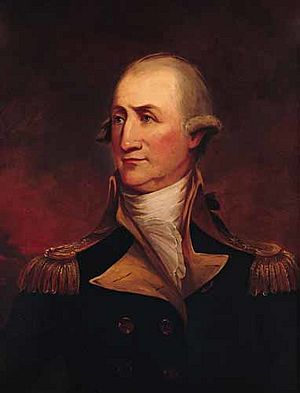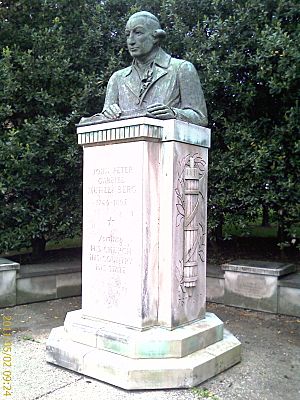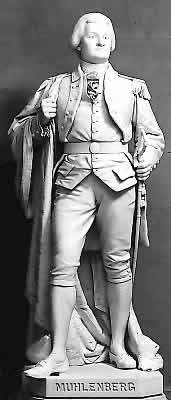Peter Muhlenberg facts for kids
Quick facts for kids
Peter Muhlenberg
|
|
|---|---|
 |
|
| United States Senator from Pennsylvania |
|
| In office March 4, 1801 – June 30, 1801 |
|
| Preceded by | William Bingham |
| Succeeded by | George Logan |
| Member of the U.S. House of Representatives from Pennsylvania's 4th district |
|
| In office March 4, 1799 – March 4, 1801 |
|
| Preceded by | John Chapman |
| Succeeded by | Isaac Van Horne |
| Member of the U.S. House of Representatives from Pennsylvania's at-large district |
|
| In office March 4, 1793 – March 4, 1795 |
|
| Preceded by | Constituency established |
| Succeeded by | Constituency abolished |
| In office March 4, 1789 – March 4, 1791 |
|
| Preceded by | Constituency established |
| Succeeded by | Constituency abolished |
| 8th Vice-President of Pennsylvania | |
| In office October 31, 1787 – October 14, 1788 |
|
| President | Benjamin Franklin |
| Preceded by | Charles Biddle |
| Succeeded by | David Redick |
| Personal details | |
| Born |
John Peter Gabriel Muhlenberg
October 1, 1746 Trappe, Province of Pennsylvania, British America |
| Died | October 1, 1807 (aged 61) Gray's Ferry, Pennsylvania, U.S. |
| Political party | Democratic-Republican |
| Relations | Muhlenberg family Conrad Weiser (maternal grandfather) |
| Profession | Minister, Politician, Soldier |
| Signature | |
| Military service | |
| Allegiance | |
| Branch/service | |
| Years of service | 1776–1783 |
| Rank | |
| Commands | 8th Virginia Regiment |
| Battles/wars | American Revolutionary War • Battle of Brandywine • Battle of Germantown • Battle of Monmouth • Siege of Yorktown |
John Peter Gabriel Muhlenberg (October 1, 1746 – October 1, 1807) was an important American figure. He was a Lutheran minister, a brave soldier in the Continental Army during the American Revolutionary War, and a politician in the early United States. He served in both the United States House of Representatives and the United States Senate for Pennsylvania.
Contents
Early Life and Education
John Peter Gabriel Muhlenberg was born on October 1, 1746, in Trappe, Pennsylvania. His mother was Anna Maria Weiser, and his father was Henry Muhlenberg, a German Lutheran pastor. His grandfather, Conrad Weiser, was a famous pioneer and diplomat.
In 1763, Peter and his brothers, Frederick Augustus and Gotthilf Henry Ernst, were sent to Halle for their education. They studied Latin at the Francke Foundations. Peter left school in 1767 to work as a sales assistant in Lübeck, but he returned to Pennsylvania later that year.
Starting His Career
Peter Muhlenberg briefly served in the British military and then in the German dragoons, where he earned the nickname "Teufel Piet" (Devil Pete). He returned to Philadelphia in 1767 and continued his education at the Academy of Philadelphia.
In 1768, he became a minister and led a Lutheran church in Bedminster, New Jersey. Later, he moved to Woodstock, Virginia. In 1772, he visited England and was ordained into the Anglican Church. This was important because to lead a church in Virginia, he needed to be ordained by the Anglican Church, which was the official church there.
Besides his church work, Muhlenberg became involved in politics. He led the Committee of Safety and Correspondence for Shenandoah County, Virginia. He was also elected to the House of Burgesses in 1774 and attended the First Virginia Convention.
Military Service in the Revolution
Joining the Continental Army
As the American Revolution began, George Washington personally asked Muhlenberg to lead a new military unit. In late 1775, Muhlenberg was given permission to raise and command the 8th Virginia Regiment as its colonel. His brother, Frederick Augustus Muhlenberg, who was also a minister, initially disagreed with Peter joining the army. However, after the British burned down Frederick's own church, he also joined the military.
A famous story says that on January 21, 1776, in his church in Woodstock, Virginia, Reverend Muhlenberg gave a sermon. He read from the Bible, "To every thing there is a season... a time of war, and a time of peace." He then declared, "And this is the time of war," and took off his minister's robe to show his army uniform underneath. Drums began to roll outside, and many men from his church immediately joined the army. Within half an hour, 162 men signed up. The next day, he led 300 men to form the new regiment. While Muhlenberg definitely helped form and lead the 8th Virginia Regiment, historians are not sure if this dramatic sermon story is completely true, as it was first written about much later.
Battles and Leadership
Muhlenberg's unit first went south to protect the coasts of South Carolina and Georgia. In early 1777, his regiment moved north to join Washington's main army. Muhlenberg was promoted to brigadier general and commanded a brigade in Nathanael Greene's division at Valley Forge.
He fought in important battles like Brandywine, Germantown, and Monmouth. After the Battle of Monmouth, most of the Virginia troops were sent south. General Muhlenberg stayed in Virginia to lead its defense, mostly using local militia units.
At the Battle of Yorktown in 1781, Muhlenberg commanded the first brigade in Lafayette's Light Division. His brigade was part of the group that stormed Redoubt No. 10, a key British defense, on October 14, 1781. This was a brave night attack using bayonets.
When the war ended in 1783, he was promoted to major general. He then settled in Montgomery County, Pennsylvania. Muhlenberg was also an original member of the Pennsylvania Society of the Cincinnati, a group for officers who served in the Revolutionary War.
Political Career
After the war, Muhlenberg continued his public service. In 1784, he was elected to the Supreme Executive Council of the Commonwealth of Pennsylvania. He became the Vice-President of the Council on October 31, 1787. This job was similar to being a Lieutenant Governor today.
Muhlenberg was elected to the 1st Congress (1789–1791) as one of the representatives from Pennsylvania. His brother, Frederick, was even the Speaker of the House for that same Congress. Peter Muhlenberg was a founder of the Democratic-Republican Societies in 1793. He served in Congress again from 1793–1795 and 1799–1801.
In February 1801, he was elected by the Pennsylvania legislature to the U.S. Senate. However, he resigned from the Senate on June 30 of that year. President Thomas Jefferson then appointed him to government roles in Pennsylvania. He became the supervisor of revenue for Pennsylvania in 1801 and the customs collector for Philadelphia in 1802. He held this last position until his death.
Personal Life
On November 6, 1770, Peter Muhlenberg married Anna Barbara "Hannah" Meyer. She was the daughter of a successful potter. They had six children together. One of their children was Francis Swaine Muhlenberg (1795–1831), who later became a U.S. Representative from Ohio.
John Peter Gabriel Muhlenberg passed away on his 61st birthday, October 1, 1807, in Gray's Ferry, Pennsylvania. He is buried at the Augustus Lutheran Church in Trappe, Pennsylvania.
Legacy

- Muhlenberg County, Kentucky is named after him.
- There is a memorial to Peter Muhlenberg in Washington, DC on Connecticut Avenue.
- Another memorial stands behind the Philadelphia Museum of Art.
- Two statues of Peter Muhlenberg are located in front of the Shenandoah County Courthouse in Woodstock, Virginia. The Emmanuel Lutheran church in Woodstock still uses communion vessels, a baptismal font, and an altar cloth that he used.
- Muhlenberg College in Allentown, Pennsylvania has a statue of John P. G. Muhlenberg in front of its Haas College Center.


